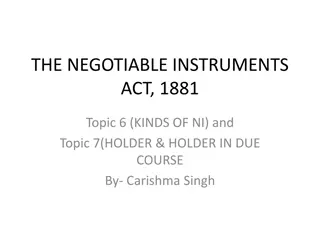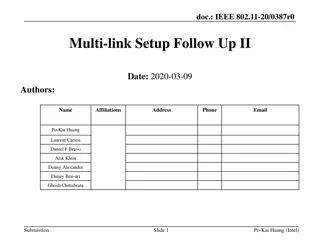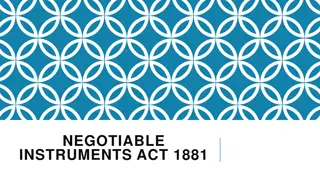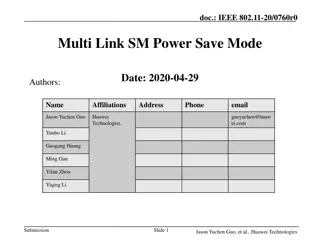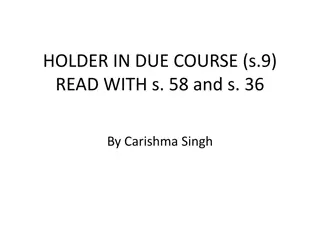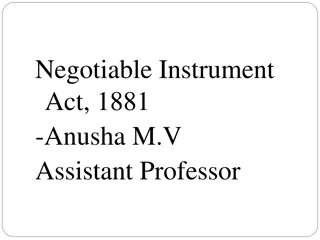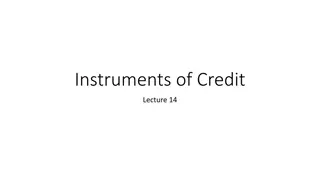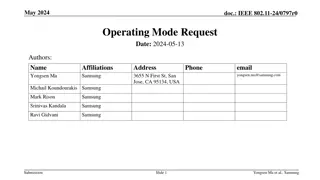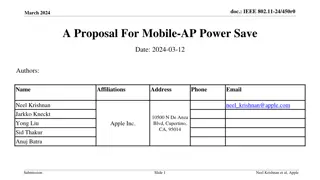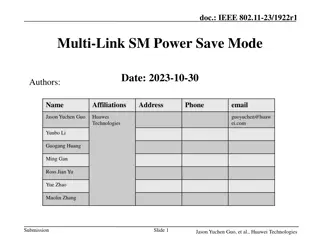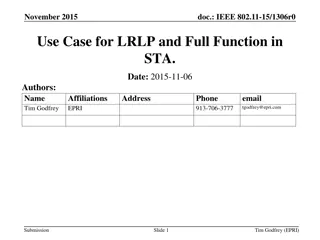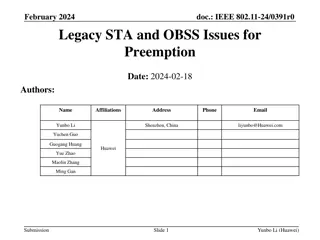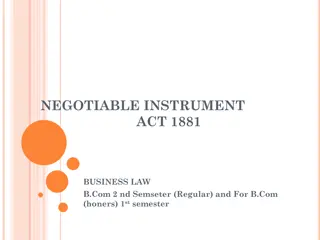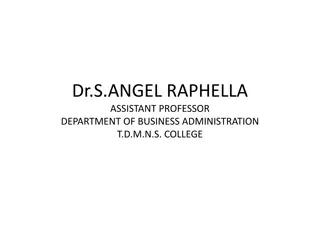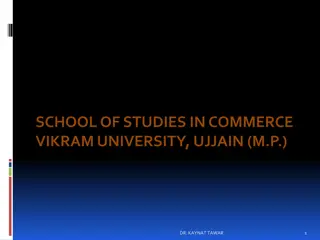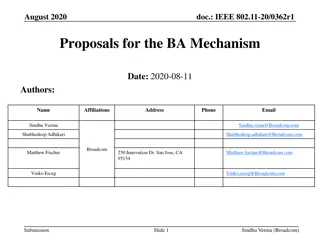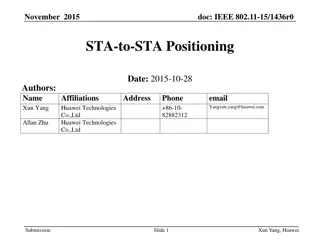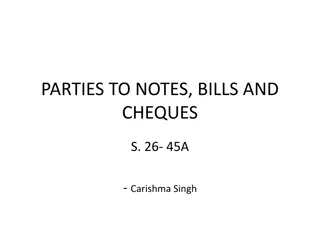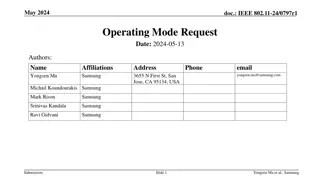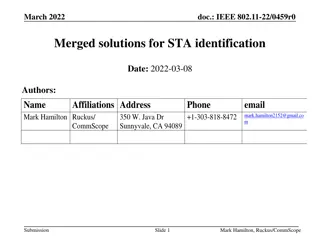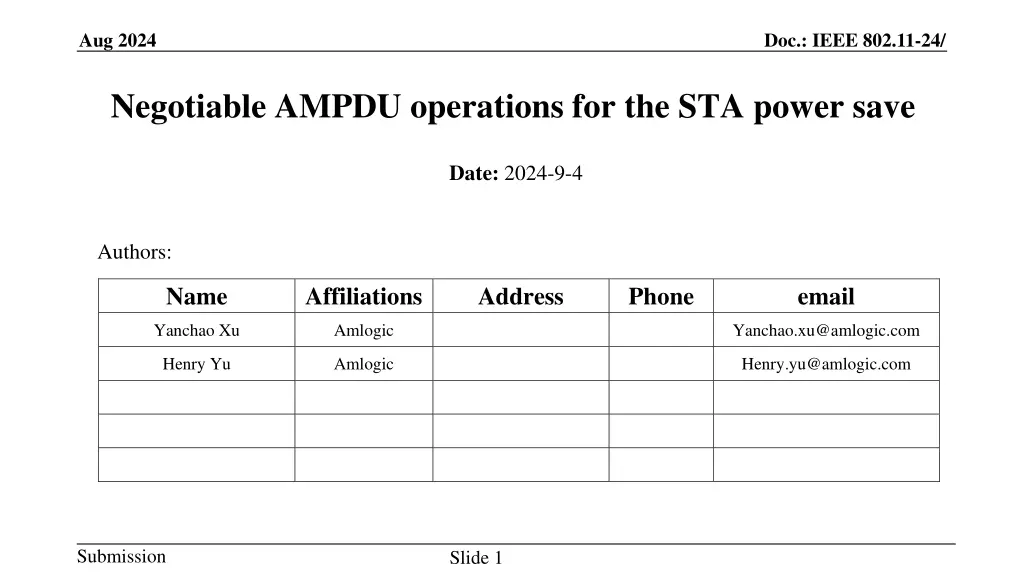
Enhancing AMPDU Operations for Lowering STA Power Consumption
Explore how to enhance AMPDU operations in IEEE 802.11 standards to reduce power consumption for STAs in unidirectional traffic scenarios. Discussion covers the use of dynamic power save (DPS) and low capability mode (LCM) to optimize power efficiency and the current state of AMPDU operations in Wi-Fi products.
Download Presentation

Please find below an Image/Link to download the presentation.
The content on the website is provided AS IS for your information and personal use only. It may not be sold, licensed, or shared on other websites without obtaining consent from the author. If you encounter any issues during the download, it is possible that the publisher has removed the file from their server.
You are allowed to download the files provided on this website for personal or commercial use, subject to the condition that they are used lawfully. All files are the property of their respective owners.
The content on the website is provided AS IS for your information and personal use only. It may not be sold, licensed, or shared on other websites without obtaining consent from the author.
E N D
Presentation Transcript
Aug 2024 Doc.: IEEE 802.11-24/ Negotiable AMPDU operations for the STA power save Date: 2024-9-4 Authors: Name Affiliations Address Phone email Yanchao Xu Amlogic Yanchao.xu@amlogic.com Henry Yu Amlogic Henry.yu@amlogic.com Submission Slide 1
Aug 2024 Doc.: IEEE 802.11-24/ Introduction Power save is one important topic that is being discussed in 11bn, and lots of power saving mechanisms have been discussed in the group For STA power save, the DPS (dynamic power save) has already passed the motion recently in SFD[1], The LCM (low capability mode) introduced in the DPS can lower the power consumption of the STA listen mode For many real use cases of STA, the practical traffic is much more uni- directional , in which there are much more DL traffics than UL traffic. For those uses cases, in this contribution, we try propose to enhance the existing AMPDU operations to further lower the STA power consumption Submission Slide 2
Aug 2024 Doc.: IEEE 802.11-24/ Recap: Unidirectional practical use cases For STA, e.g. a cell phone, many common practical use cases have many more DL traffic than UL traffic. For example, the web browsing, the online video etc. In the 11ax traffic model for evaluation [2], some traffic models have been proposed for performance evaluation. Among those traffic models, for STA, two traffic modes are almost purely uni-directional, Wireless Display (lightly compressed video) Traffic Model Buffered Video Steaming (e.g., YouTube, Netflix) Traffic Model The buffered video streaming traffic model in [2], Submission Slide 3
Aug 2024 Doc.: IEEE 802.11-24/ Recap: Common AMPDU operations For the AMPDU operations, the 802.11 standard now only keeps the HT-immediate block ack procedure. And in practical, for the SU case, almost all the implementations of Originator only use the Ack Policy of Implicit BAR, which requires the Recipient responses a BlockAck immediately. The Ack Policy of Block ACK (Explicit BAR) is seldom used in the SU case. And the current standard also does not define procedures to explicitly enable the use of the Explicit BAR Submission Slide 4
Aug 2024 Doc.: IEEE 802.11-24/ Recap: Common AMPDU operations For the Wi-Fi product, its Transmission power consumption can be quite different (larger) from the Reception power consumption, The difference varies hugely per implementation. For same cases, the Tx power consumption (>1000mW) can be 10x larger than that of Rx power consumption (< 100mW) Here are some public research about the Wi-Fi (Tx/Rx/Idle) power consumption, The reference [3] about earlier 11n devices shows that Tx power consumption can be ~1.5x larger than that of Rx for some MCS/BW The reference [4] about 11n/11ac devices shows that Tx power consumption can be 4x~5x larger than that of Rx for some MCS/BW The reference [5] (11ax simulation scenarios) lists a power table that require the Tx power consumption can be 1.4x~2.8x larger than that of Rx for different BWs Although the BA usually uses lower MCS and 1ss, its Tx power consumption can also be very large Especially for some cases when the STA is far away from the AP, the STA will increase its Tx power to improve the successful transmission of the BA response Submission Slide 5
Aug 2024 Doc.: IEEE 802.11-24/ Proposal: Negotiable AMPDU Ack Policy operation For the DL traffic use case, to lower the total power consumption, we may try to reduce the number of the BA transmission of STA The STA(as Recipient) can recommend the Originator to use different Tx AMPDU Ack Policy for the corresponding BA agreement The conditions that Recipient may recommend to use Explicit BAR may include, The reception MPDU PER is not bad The corresponding traffic is not very latency sensitive The corresponding traffic does not have very low throughput The AP(as Originator) can accept or deny the recommendation Because the Explicit BAR without immediate BA response will require the Originator to have stronger buffer capabilities, as the transmitted MPDUs cannot be released until they are acknowledged (or dropped due to lifetime expiration) Submission Slide 6
Aug 2024 Doc.: IEEE 802.11-24/ Proposal: Negotiable AMPDU Ack Policy operation When AP (as Originator) accepts the recommendation of using Explicit BAR Ack Policy, the Originator can try to use Explicit BAR for (some of ) the AMPDUs it transmits To solicit the BA response, the Originator s behavior can vary based on actual implementations. For example, the Originator may (periodically) transmit AMPDU with Implicit BAR to solicit immediate BA response. Or, (periodically) transmit BAR to solicit immediate BA response The Originator s behavior may base on the corresponding traffic characters, e.g. the period/delay bound Submission Slide 7
Aug 2024 Doc.: IEEE 802.11-24/ Simulation Here we use the Buffered Video Streaming (e.g., YouTube, Netflix) Traffic Model in [2] to simulate the power consumption benefit of using Explicit BAR over Implicit BAR In [2], based on the specification of the video streaming bit rate(e.g. 480p/30fps, 1080p/60fps), there are different parameters to simulate those different video bit rate The BV1 may correspond to 480p/30fps The BV6 may correspond to 1080p/60fps As the online video today has much higher quality, we use another higher video bit rate corresponding to 2K/60fps The BV7 that has video bit rate of 25Mbps, lambda of 86875 Submission Slide 8
Aug 2024 Doc.: IEEE 802.11-24/ Simulation The characters of the Buffered Video Streaming traffic model, Step 1: The video packet size is generated at constant interval, but with random packet size. At application layer, generate video frame size (bytes) according to Weibull distribution with the following PDF. Step 2: AT TCP layer, set TCP segment as 1500 bytes and fragment video packet into TCP segments. Step 3: Add network latency to TCP/IP packets when these segments arrive at AP for transmission. The network latency is generated according to Gamma distribution whose PDF is shown below Where k=0.2463 theta=60.227 So in the view of MAC, the MSDUs are arriving with different/random sizes and different/random frame interval Submission Slide 9
Aug 2024 Doc.: IEEE 802.11-24/ Simulation The characters of the Buffered Video Streaming traffic model, Random size of packet size and random arrival time at the MAC layer The below figure shows the MSDU (TCP segment) size and real time throughput for the BV7 (target video bit rate of 25Mbps) simulation This shows a BV7 streaming lasting 25 seconds The blue dot shows the TCP segment size at each time As the video packet size follows Weibull distribution, the TCP segment may have different size at different time And the arrival time of each TCP segment is also non-constant The yellow line shows the real time TCP throughput The real time TCP throughput varies as the size/arrival time of TCP segment varies The yellow line shows an average TCP throughput of 23.8Mbps, which is close to the BV7 target video bit rate of 25Mbps Submission Slide 10
Aug 2024 Doc.: IEEE 802.11-24/ Simulation Total power consumption calculation For the 60fps video streaming, we generate video packet every ~16ms (1/60). Typically, the STA will not enter sleep mode with such a short frame interval So during the active time of STA, we divide the STA working mode into 4 states: Listen Mode: STA is neither Tx or Rx, and there is not any signal on working channel PacketDetect Mode: STA is receiving the preamble of a Rx PPDU. In our simulation, it lasts the duration of pre-HE portion Rx Mode: STA is receiving the rest of the Rx PPDU. In our simulation, it begins from the HE portion of the Rx PPDU Tx Mode: STA is transmitting We will accumulate the time duration for each STA active state during a certain time, and the total power consumption will be the sum of the power consumption of each active state P_total = (Duration_PD_Mode x Power_PD_mode) + (Duration_Listen_Mode x Power_Listen_mode) (Duration_Rx_Mode x Power_Rx_mode) + (Duration_Tx_Mode x Power_Tx_mode) ; Submission Slide 11
Aug 2024 Doc.: IEEE 802.11-24/ Simulation Total power consumption calculation As our target is to compare the total power consumption difference between method with Explicit BAR and method with Implicit BAR, the absolute power consumption of each active state is not important. So in our simulation, we Set the Power_RX_mode to 1 Set the Power_PD_mode to (0.9*Power_Rx_mode) Set the Power_Listen_mode to (0.6*Power_RX_mode) Assuming there is DPS mode that introduces lower power consumption in the Listen mode For the Power_TX_mode, we set different levels of Tx power consumption to see the different results caused by different Tx power consumption In our simulation, we set Power_TX_mode to be [1.2, 1.5, 2, 2.5, 3, 4, 5] times of Power_RX_mode The retransmission is also considered in the simulation. We use 4 different MPDU level PER: 0/0.05/0.1/0.15. The retransmission time and power consumption is also accumulated in the total time/power consumption calculation Submission Slide 12
Aug 2024 Doc.: IEEE 802.11-24/ Simulation Simulation Result 1 for BV1 Traffic Model: BV1 with target video bit rate of 2Mbps Use HE MCS9/BW80/1x1 constant rate For Explicit BAR, Originator uses BAR to solicit BA response Record the total power consumption during 24 seconds for both Explicit BAR and Implicit BAR In the left figure, X Axis is the different level of Tx power consumption Y Axis shows the gain of the total power consumption with Explicit BAR over that with Implicit BAR (in percentage) For the BV1 of 2Mbps, as the traffic throughput is too low compared to the MCS9/BW80/1x1(480Mbps), the gain is more obvious when the Tx power is > 4x of Rx power, in which the gain can be > 2% Submission Slide 13
Aug 2024 Doc.: IEEE 802.11-24/ Simulation Simulation Result 2 for BV6 Traffic Model: BV6 with target video bit rate of 2Mbps Use HE MCS9/BW80/1x1 constant rate For Explicit BAR, Originator uses BAR to solicit BA response Record the total power consumption during 24 seconds for both Explicit BAR and Implicit BAR For the BV6 of 15.6Mbps (actual average throughput is 15.9Mbps), the total power consumption gains of Explicit BAR over Implicit BAR are more obvious. When the Tx Power is > 4x larger than Rx Power, the total power consumption gain can be > 10% Submission Slide 14
Aug 2024 Doc.: IEEE 802.11-24/ Simulation Simulation Result 3 for BV7 Traffic Model: BV7 with target video bit rate of 25Mbps Use HE MCS9/BW80/1x1 constant rate For Explicit BAR, Originator uses BAR to solicit BA response Record the total power consumption during 24 seconds for both Explicit BAR and Implicit BAR For the BV7 of 25Mbps (actual average throughput is 23.8Mbps), when the Tx Power is > 3.5x larger than Rx Power, the total power consumption gain can be > 10% Submission Slide 15
Aug 2024 Doc.: IEEE 802.11-24/ Summary In this contribution, we provide a proposal to enable STA (as Recipient) to recommend Originator to use a different Ack Policy from that already used in the Originator s Tx AMPDU. For some certain use cases, by using the Explicit BAR, it can decrease the number of the BA frames transmitted by STA (as Recipient) We also provide a simulation with online video use case to show the total power consumption gain of the method with Explicit BAR over that with Implicit BAR Submission Slide 16
Aug 2024 Doc.: IEEE 802.11-24/ SP Do you support that an UHR STA as a Recipient of a RX BA agreement can recommend its peer Originator to use a specific Ack Policy in the Originator s transmitted AMPDUs? The recommended Ack Policy can be Implicit BAR or Block Ack (Explicit BAR) The Originator can accept or deny the recommendation The exact signaling method is TBD Submission Slide 17
Aug 2024 Doc.: IEEE 802.11-24/ References [1] 11-24-0209-06-00bn-specification-framework-for-tgbn [2] 11-15-0590-02-00ax-traffic-model-updates-to-evaluation-methodology [3] Demystifying 802.11n Power Consumption [4] Power-Throughput Tradeoffs of 802.11n/ac in Smartphones [5] 11-14-0980-16-00ax-simulation-scenarios Submission Slide 18

